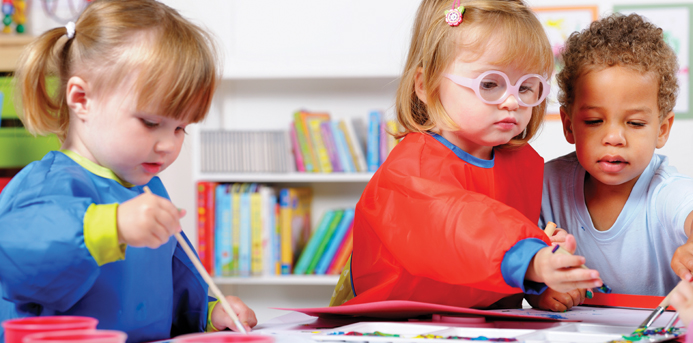Co-ops, Montessori, Reggio Emilia. These days, parents of preschool-aged children face more choices than ever.
To help navigate the process, we’ve put together a cheat sheet of some of the most popular preschool options. We might not be able to make the decision for you, but we hope we can at least help send you (and your little one) in the right direction.
Montessori
What is it?
Teaching philosophy developed by physician and educator Maria Montessori in the early 20th century.
Emphasis
Fostering independence, personal responsibility and learning through child-initiated activities. Classrooms tend to be large with kids ranging in age from 2 1/2 to 6. Teachers act as facilitators, encouraging students to learn through discovery rather than direct instruction, and many activities include real world applications such as learning to tie shoes or prepare classroom snacks. The multi-age classroom creates a unique dynamic, as older children are encouraged to mentor their younger counterparts, which leads to a greater sense of responsibility and strengthens leadership skills.
Co-op
What is it?
A parent-run preschool program.
Emphasis
Parent involvement defines a co-op, which is typically run and maintained by a governing group of volunteer parents. Co-op preschools are usually play-based and their enrollment fees tend to be lower than other schools, as the staff is supplemented by volunteers. On the flipside, parents are expected to donate large amounts of time to the school, which can vary from doing administrative tasks to helping in the classroom.
Reggio Emilia
What is it?
Teaching philosophy developed in Reggio Emilia, Italy in the 1940s.
Emphasis
Children learn about the world around them through inquiry, exploration and discovery. Teachers facilitate learning by creating a dynamic environment where authentic art materials, found objects, and the natural surroundings engage children while they follow their innate interests and curiosities. Teachers document the children’s learning process with pictures, notes, quotes and recordings, which offers a unique way for parents to see their child’s development as it evolves. Most Reggio classrooms encourage parent participation and often host educational workshops for parents and the community at large.
Play-Based
What is it?
An educational approach dedicated to learning through active play.
Emphasis
Play-based preschools use “play scenarios” such as dress up centers, art projects, sensory tables, and games as a way to help children learn about the world around them. Play builds creativity, imagination and problem solving skills while helping children learn how to follow rules, share and negotiate with their peers. Play advocates believe long periods of uninterrupted play builds a child’s ability to concentrate and creates an inner motivation to discover and explore, which in turn can develop into a lifetime love of learning.
Academic- or Cognitive-Based
What is it?
An educational approach dedicated to teaching children basic academic skills such as math and reading.
Emphasis
Advocates of academic preschools (which are sometimes called “cognitive based” preschools) believe children are like little “sponges,” able to soak up as much information as we give them. These classrooms tend to use direct instruction to introduce key academic concepts such as math and reading. Critics of academic preschools believe these schools put too much pressure on preschoolers, as there is not enough emphasis on social and emotional development. However, others believe academic preschools best prepare children for kindergarten, which has become increasingly more rigorous over the past 10-15 years.
Religious or Faith-Based
What is it?
A preschool program grounded in an underlying religious faith.
Emphasis
Most religious preschools are housed in a religious institution such as a church or temple. The curriculum usually highlights religious holidays, themes and traditions but their teaching philosophy (Reggio Emilia-inspired, play-based, etc.) will vary depending on the school. When looking at a religious preschool, consider how the school integrates religion into its day-to-day activities as well as how they approach child development.
Public Preschools
What is it?
Most local school districts offer a public preschool option for 3- and 4-year old students.
Emphasis
Qualifications for these programs vary, but is often based on a family’s financial background as well as the child’s social/emotional development, cognitive abilities or language skills. For example, some public preschools accept students who qualify based on their family’s income while others include students who are viewed as “at-risk” or speak English as a second language. Public preschools also serve children with special needs. If you are interested in a public preschool option, contact your local school district to learn about their programs and requirements.

